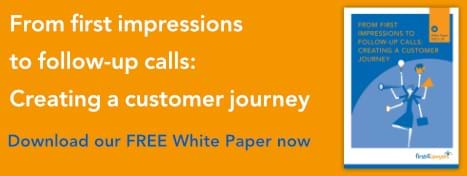Customer Journey Content: Give Visitors What They're Looking For

When a visitor lands on your site, they’re looking for a need to be met.
There may be times when they don’t know exactly what it is they’re looking for, but everyone will be at a particular stage in their journey towards – hopefully – converting into a client.
And that means certain pieces of content will be most appropriate for certain visitors. So what does that mean for your firm?
Incorporating the marketing funnel
If you’ve paid any attention to marketing or sales terminology, you may have heard of the marketing funnel. This is typically expressed as a diagram, which shows the different stages involved in a buying decision.
These are generally:
- Awareness
- Interest
- Consideration
- Intent
- Evaluation
- Purchase
There are various iterations of the funnel, but they generally follow that outline. There are some differences between consumer and business-focused funnels, but they also tend to follow a similar outline.
The gist is that different forms of content are relevant to these stages. Think about what you might look for when you’re searching for a new service provider. What you want at the beginning of your search is different to what you’d need when you’d decided on a provider and were about to make the purchase.
To simplify matters, we can look at the funnel as featuring three overarching stage categories – attract, evaluate and conversion. These cover the main stages a potential client might venture through as part of the customer journey.
You’ll then need to produce the appropriate content for each stage to keep them engaged.
The right content for the journey
User intent and buyer stage are inextricably linked. Providing the right sort of content will help you meet user intent and give your site visitor what they’re looking for.
Certain forms of content are most appropriate for each stage:
- Awareness stage
When someone realises they have a need for something – whether that’s buying a new product or finding a solicitor – they often take to a search engine to look for what they need. They might then do some research and look at a few sites.
Therefore, high-level explanatory information is most appropriate for prospective clients in this stage of their journey. Explainer videos, blogs, social media posts or even podcasts can help people learn about what you do and how you could help them.
This sort of content can help to generate enquiries and leads by highlighting your firm as an industry expert. But there is often an advantage to producing content that doesn’t have lead generation as its goal.
Creating purely informative pieces can increase your brand presence online, thereby raising awareness and helping to keep your firm at the forefront of people’s minds when they do need your services.
- Evaluation stage
In the middle of the funnel, visitors are evaluating whether your firm can do what they want. That necessitates a different sort of content.
At this stage, you want to build trust in your brand. This is where you offer something useful that adds value to your visitor. This could be a checklist, quiz, downloadable resource or how to guide – as long as it goes into detail about a specific issue your client is having.
Making these insightful and helpful pieces of content easy to access can help foster a sense of goodwill. This will go down better with visitors than if they have to enter their details – or even pay – to find the information they’re looking for.
These types of content can also help you rank higher on search engines – provided they’re well optimised and relevant to user intent. And that has the resulting benefit of helping you reach more people looking for your services.
- Conversion stage
At the bottom of the funnel, your prospective client may have a shortlist of firms they’re weighing up giving their business to. This is where the comparative content plays its part. You want to show that you’re the right fit. And even if there’s no shortlist and you’re the only option, this kind of content can help a site user convert into a lead.
Content that shows how other people found working with your firm is appropriate for this part of the funnel. Think about your case studies or client stories. If you’ve managed a case from start to finish for a client, you’ll have a wealth of information to share.
You can also focus on your client reviews. For this reason, it’s worth maintaining a presence on review sites, like Trustpilot. Don’t forget to actively encourage clients to leave a review of their experience with your firm. If they’re not overwhelmingly positive, look at it as an opportunity to improve your service and to engage with disgruntled clients to help them have a better overall experience.
And although not quite content, live chat and other communication channels through your site can fall under the conversion stage. This is what could really get a prospect over the line, so don’t forget how interlinked customer service and marketing are.
Giving users what they need
Although your site users may not have an awareness of what stage they’re at in the funnel, they will have a need they want met when they land on your site.
It’s then up to you to provide the right information for that need.
Giving visitors what they need doesn’t have to be difficult. All you have to do is make sure your site provides enough types of content to raise awareness, engage with them and convince them to convert.


